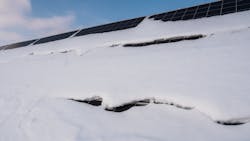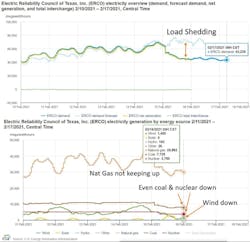Is Renewable Energy a Threat to Grid Resilience?
In the wake of the crippling cold, ice and snow that has swept across Texas, politicians, media personalities and influencers have seized an opportunity to shift blame onto overreliance on renewable energy in the state rather than address the real causes of the major electric power failure in ERCOT.
Pictures of frozen wind turbines (some of which have reportedly been sourced from Sweden) litter the feeds of many on Facebook and Twitter, while Texas Governor Greg Abbott took the opportunity on Tuesday night on a Fox News appearance to note how the unfurling of Texas’ electric outages “shows how the Green New Deal would be a deadly deal for the United States of America,” even after he said wind only supplied about 10% of the power needed by power customers in ERCOT. BBC News pointed out, “Critics pointed to a loss of nearly half of Texas’s wind-energy capacity as a result of frozen turbines, they failed to point out double that amount was being lost for gas and other non-renewable supplies such as coal and nuclear.”
The story being told is that renewable energy, while nice in theory, is not reliable in the face of catastrophic climate-related events.
"We are at the same amount of power needed in the state today than we were in August of 2020, which was the highest megawatt usage in Texas history…If wind and solar is where we’re headed, the last 48 hours ought to give everybody a real pause and go wait a minute,” said former Texas Governor and Energy Secretary Rick Perry on the blog of U.S. Congressman Kevin McCarthy.
What Happened?
Like most news headlines, reality is a lot more complex. The power outages and lack of supply being faced in Texas are the result of many unique factors coming together. Pardon the pun, but this was a perfect storm.
The State of Texas runs an independent, deregulated, and mostly isolated electric market known as ERCOT, and has since 1970. ERCOT was intentionally designed in this manner to avoid federal regulation. In 2002 ERCOT introduced independent power marketers to the mix. The incentive was low cost electricity. Reliability wasn’t part of the equation. As a result, closely balanced supply and demand maintains competitive rates, most of the time, but the state has limited access to resources from other markets because effectively ERCOT is an island remote from the established power grids of North America. In this instance, many parts of the state were without the option of an external power source.
“Texans would be without electricity for longer than three days to keep the federal government out of their business,” said Perry. “Try not to let whatever the crisis of the day is take your eye off of having a resilient grid that keeps America safe personally, economically, and strategically.”
We don’t share his confidence that all Texans would agree with that sentiment.
The onset of extremely cold weather also caused an unforeseen spike starting on Feb. 14, over 69GW, in electric demand causing an imbalance in supply and demand. This imbalance forced utility providers to implement rolling blackouts to maintain safe operating conditions. Operational problems ensuing at the generation plants also forced thousands of MW of power offline, extending the power outages for hours and days.
Were Renewables to Blame?
According to data released by ERCOT on Tuesday, Feb. 16, 2021, some 16 GW of renewable capacity was inaccessible alongside 30 GW of natural gas fired, coal fired, and nuclear power. In summary, both renewable and traditional baseload generators failed, right when they were needed the most. While renewable generation failed due to icing and lack of sun, other thermal generation facilities failed due to issues like frozen natural gas pipelines, coal piles, and cooling water needed for electricity production. Additional demand on natural gas for heating further reduced generation fuel resources.
The charts below illustrate the grid imbalance as well as the impact on electric generation plants for each type of energy source.
"Everyone just shut the f--- up, and let the experts sort out what’s happening," Neil Chatterjee, a Federal Energy Regulatory Commission commissioner, told the Washington Examiner.
“Both sides are playing games," Chatterjee said. "This gets back to the politicization of everything energy. We have this situation occur, much like rolling blackouts in California, and everyone retreats to their corners and views this through a fuel source partisan lens. Let's have everyone calm down for a moment, and why don't we take the politics out of this?"
Indeed, why don’t we? Let’s start with the myth that wind turbines and other renewable generation facilities lack the ability to withstand severe winter conditions. “The challenges are less about engineering and more around the financial tradeoff for particular design criteria when designing new assets,” says Holger Peller, VP and head of POWER Engineers power delivery division.
Wind turbines supply power in places such far north as Norway, Sweden, Iceland etc. throughout the winter months. There are also documented cases of solar power microgrids being the only source of electricity after hurricanes. Renewable resources are reliable when good engineering practices are followed for the climate conditions they will face.
“With respect to the frozen wind turbines, the technology exists to keep wind turbines functional in extreme weather conditions, but such conditions are extremely rare in Texas and so the payoff for the additional cost is hard to justify,” says Peller.
Peller also noted that additional safeguards ultimately end up on the consumer’s bill. Because utilities and regulatory bodies are committed to keeping electricity rates low and there will always be a tradeoff between keeping prices competitive and ensuring maximum reliability, particularly as extreme weather taxes the limits of our systems.
Resilience in the Face of Climate Change
“It is mostly agreed across the world that we have to reduce our carbon emissions for the long-term health of our planet. Moving towards renewable energy sources is not an option in the long run--it’s required,” says Peller.
“What this event brings into sharp focus is that our daily lives are integrally dependent on electricity, more so now than ever before. So, we need to design a measured transition from our carbon-based generation today to more renewable generation in the future, and continue to invest in R&D to further the technology that will enable us to move more and more towards full renewable generation—such as long-term energy storage. There is urgency that we make the transition to renewable energy quick enough to keep our planet healthy, and we must move slow enough that the technology can be developed to keep our reliability high.”
In California, a summer 2020 heat wave forced utilities in the state to implement rolling blackouts, while severe wildfire threat also imposed multiple public safety power shutoffs. Utilities in that state are actively pursuing ways in which they can minimize the need to impose PSPS through increased redundancy, local measures such as microgrids and mobile generation, and system hardening.
Renewable energy is not spelling out trouble and doom for our power grids, and it likely won’t in the foreseeable future. The Texas event illustrates that we are having trouble with large scale extreme weather events, and a deregulated market that is not well interconnected with the rest of the nation’s electric grid. Why aren’t we asking the question, “how can we establish market mechanisms and operating environments that go hand in hand with equitable reliability and access to clean energy?
About the Author
Lauren Callaway
Senior Content Manager
Martha Davis
Senior Director of Content
Prior to working at T&D World and Utility Analytics Institute, Martha worked as an executive in the energy industry for about 15 years. She has held various regulatory and government affairs positions and had the opportunity to shape public policy.
Martha has a B.A. from Westminster College in Fulton, MO; completed specialized legal and public policy coursework at American University in Washington, D.C.; M.P.A. Public Affairs and M.B.A. Business Administration both from the University of Missouri. She is currently a doctoral candidate at the University of Denver where she is researching business analytics, innovation and regulation.

